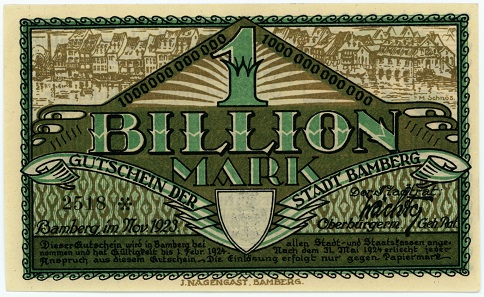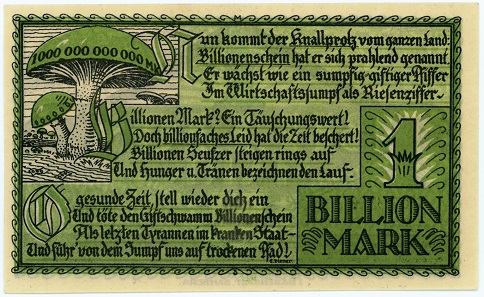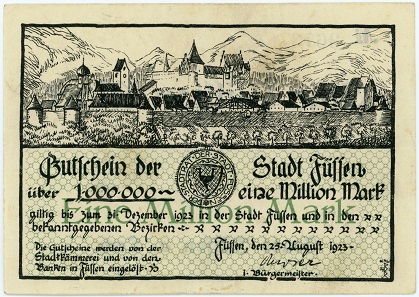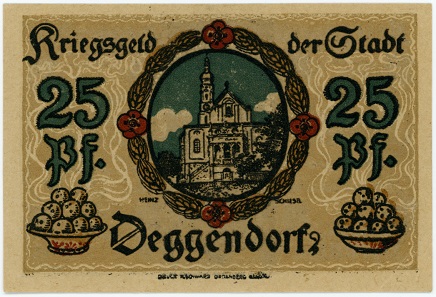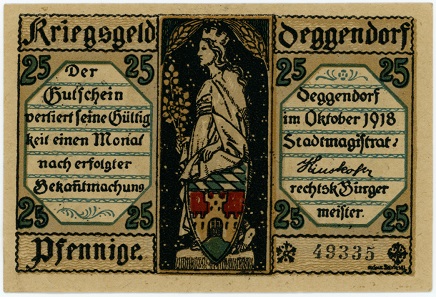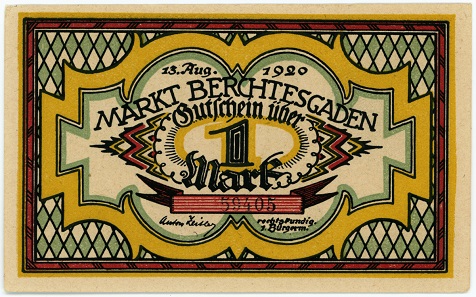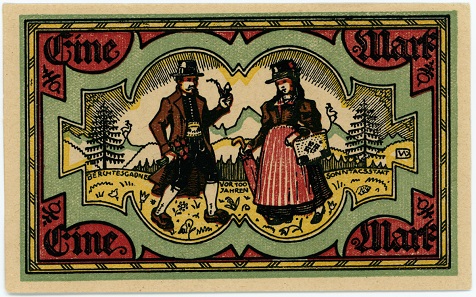by Katharina Depner
July 19, 2018 – A 1-trillion-mark note issued by the town of Bamberg in 1923 reads “Now the braggart comes from all over the land, boastfully calling himself a trillion note”. This emergency banknote leads us to the era of hyperinflation and economic crisis, which ended in 1923 with the collapse of the monetary system.
The virtual exhibition titled “Nun kommt der Knallprotz vom ganzen Land – Emergency Money in Bavaria 1914-1923” explores this topic. Selected objects illustrate the development and impact of inflation in Germany between 1914 and 1923, focusing on the function, distribution and design of emergency money.
A 1-trillion-mark note issued by the town of Bamberg in 1923.
The function and issuance of emergency money
With its tremendous need for metal, the war effort of World War I and inflation together led to a shortage of cash between 1914 and 1923. Legal means of payment, such as coins and banknotes, issued by the Reichsbank, were no longer available in sufficient quantities. Emergency money was issued as replacement currency in order to maintain daily payment transactions. This meant that wages, rents and purchases could still be paid in cash.
Three main parties issued emergency money in Bavaria: public authorities, banks and companies. The emergency banknotes were only valid within a certain area or district and for a limited period of time. Once the shortage of currency was resolved, the issuing authority called for the emergency money to be redeemed. The emergency money was exchanged for coins or imperial banknotes (Reichsbanknoten), thereby becoming null and void.
The town of Füssen issued this 1-million-mark note in 1923.
The production of emergency money
The production methods were as diverse as the emergency money itself. Most printing houses were based in the same region as the issuer. Some printers also produced emergency banknotes at national level; most of the bills were identical, the only difference being formal details, such as the issuer’s name.
The design and substrate often depended on the issuer. Generally, no special banknote or security paper was used; instead, the bills were chiefly made of paper or cardboard. Authorities frequently commissioned their own emergency money, while banks used existing cheque forms. Companies also used the blank backs of their headed business paper to issue emergency money.
The sculptor and graphic artist, Heinz Schiestl (1867-1940) achieved fame for his designs of emergency money. In cooperation with the Schwarz printing house of Lindenberg in the Allgäu region, he designed and produced emergency banknotes for 57 towns and cities throughout Germany. For each series, Schiestl studied the history of the respective town or city and specific local features in great detail, incorporating them in his designs. For Deggendorf’s motif, he chose the legend of the “Deggendorfer Knödel”: during a siege of the town by Ottokar II of Bohemia during the 13th century, the mayor’s wife is alleged to have hurled a dumpling she was preparing for her husband’s dinner at a Bohemian scout, thereby causing the enemy to retreat and saving the town from capture.
This 25-Pfenning note was issued in Deggendorf shortly before the end of the First World War.
Emergency money motifs
Dirndls and steamers – emergency money often features motifs that reflect a region’s culture and industry. Recurring themes on emergency banknotes range from historical events to prominent public figures and local dialects. Other illustrations include the aftermath of war and inflation, which were lambasted in critical poems. Moreover, as familiar motifs, coats of arms and city sights were an important factor in ensuring the population’s acceptance of emergency money as legal tender.
A colorful 1-mark note from Berchtesgaden, 1920.
This exhibition is a project of the HVB Stiftung Geldscheinsammlung Munich (HVB foundation of banknote collection) and is is presented on “bavarikon”, a online portal for art, culture and regional history of the Free State of Bavaria. Selected holdings are presented, focusing on “Paper Bills in Bavaria” and “Rare banknotes from all over the world”.
The virtual exhibition “Nun kommt der Knallprotz vom ganzen Land – Emergency Money in Bavaria 1914-1923” can be found on the bavarikon website.
Click here for the presentation of the HVB Stiftung Geldscheinsammlung on bavarikon.




